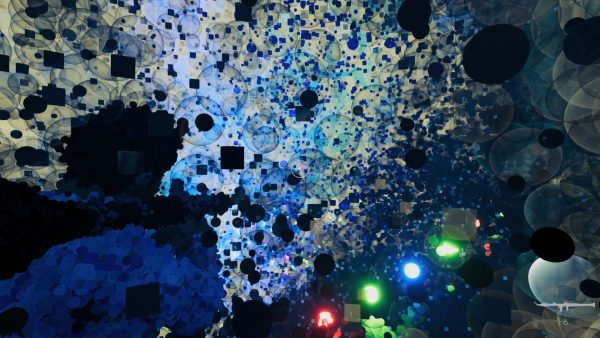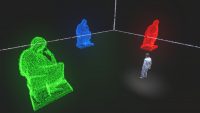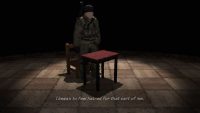Switch to: German
No creation without destruction: In Dreams of Another, The Man in Pajamas and the Wandering Soldier turn some classic video game tropes upside down.
Helmed by Tomohisa “Baiyon” Kuramitsu, Dreams of Another is the latest game by Japanese veteran developer Q-Games (PixelJunk franchise). While we could finally put the PS Move controllers in PixelJunk 4am for PS3 to good use, Dreams of Another uses more conventional input methods such as a regular controller and mouse and keyboard, and it also supports PlayStation VR2 which we haven’t tested. Our protagonist The Man in Pajamas teams up with The Wandering Soldier in a dream-like world in this charming story of self-discovery.
The world of Dreams of Another is abstract by design and combined with its it’s low-poly models made up of large numbers of individual pixels and the game’s watercolor optics, Q-Games manages to create very unique visuals. In 3rd-person view, The Man in Pajamas uses his machine gun to shoot everything in his way to materalise the world around him – creation through destruction. On your journey, you encounter no less than 190 unique objects, all of which have a soul called Aura. They tell us of their needs, worries, and dreams. A vending machine directs their complaint onto us regarding noisy coins, angel statues utter things you may find inside a fortune cookie, only to challenge their validity immediately, and a group of crates worries about their reputation, as they look a bit intimidating. The amusement park’s manager dressed in a clown’s costume decided to wrap yellow and black tape around them, after all they contain toilet paper. We can also take a listen to these sentiments again via the menu.
Some objects drop a blue fluid which lets us hear their feelings and clears the immediate area for good. Otherwise, we have to shoot the constantly returning pixel masses again to be able to move around. Lost auras also need to be shot in order to calm down and help us on our current quest. Once the manhole cover is emotionally receptive again, we’re able to descend to a family of moles who aids us in fulfilling a local boy’s troubled by problems in his family final wish before moving: to hear the enchanting piano one last time. During a visit from an important client, we help the aforementioned clown restore decommissioned rides at Heaven’s Door amusement park. To do this, we shoot down the gondolas of a ferris wheel or the cups of a coffee cup carousel.
Elsewhere, we assist a group of fish, including a particularly entertaining moray eel, in escaping from an aquarium and to release them into the sea to their long-awaited freedom. Here, we face off with a shipwreck and its cannons. These scenes, even though they’re presented as such, aren’t proper boss fights, as we can’t die in them.
In a competition, we’re looking for a robot to succeed a celebrated painter. Among them are a pair of robots fighting each other, one robot wanting to create while the other is bent on destruction. We encounter this theme throughout the game, time and time again. The game constantly swaps between these different scenarios until we’ve solved them. If we miss the interaction with an amusement park ride, the scene will come up again later. On the one hand, it’s we applaud the lack of handholding in order to discover things for ourselves but on the other, this can feel like an unnecessary extension of Play time, which at four to five hours is already quite short.
Collecting odds and ends enable us to unlock powerful weapons, like grenades and a rocket launcher. Using heavy weapons, we’re able to pulverize pixel barriers in no time. Odds and ends can also be used to acquire new abilities like sprinting or seeing white guide lines that point us to the next objective. There’s no quest log or an excessive on-screen HUD. In-between exploring smaller scale areas, we’re faced with playable flashbacks which expand on the backstory of each protagonist. Some environmental puzzles manage to break up the gameplay loop.
While all of the side content explores interesting themes such as the definition of art and some content is pretty bizarre or hilarious at times, the main story takes on a more serious tone. In the middle of a war zone, The Wandering Soldier can’t bring himself to shoot another person which results into him getting wounded and suffering psychologically from the consequences of war. As the game progresses, The Wandering Soldier asks us elemental questions, and depending on our answers, the game world may treat us differently. He wants to know when we come to the conclusion to throw things away, and we can reply by waiting until they’re broken, they became useless, or when we feel like it. In a handful of playable flashbacks, we experience formative moments for the two protagonists in sometimes heartbreaking moments, such as the soldier bidding farewell to his one true love, or a young Man in Pajamas growing fond of a stray cat. The ending brings the game to a close, but still leaves some questions unanswered. In New Game+, we retain our progress of acquired upgrades, unlocked tips and sentiments, the collected odds and ends, and our ammunition.
As expected, Baiyon’s soundtrack is excellent, though some scenes are so short that we hear very little of them. The ethereal music and each of the multitude of sounds effects blend with the game’s unique aesthetics in creating a dream-like experience. The quality of the English voice acting is also excellent, as is the imaginative German localization of the on-screen text.
Dreams of Another supports HDR (High Dynamic Range) on PC and console, which contributes to the colorful visuals. On PS5 Pro, the game runs at up to 60 frames per second with support for VRR (Variable Refresh Rate). In the version provided to us before the game’s release, we initially encountered a few performance issues on PS5 Pro. Even with VRR, however, we observed drops below 50 FPS in areas with particularly high pixel density using a corresponding TV. Since then, several updates have been released, and in New Game+, we couldn’t find any frame rate drops below 60 FPS, even upon the dense pixel clouds exploding in spectacular fashion.
On PC, the game offers the following graphics settings: quality preset, point cloud density, rendering scaling, and shadows. We would’ve liked to have seen a percentage displayed for resolution scaling, but instead there are the same levels as in the other graphics options. In fullscreen mode, the game seems to automatically switch to a borderless windowed mode without separately offering such an option. The output resolution equals your desktop resolution and it can’t be changed neither in windowed nor fullscreen mode. The game’s frame rate is locked to 60 FPS on PC, just like on console. Differing options, such as an unlocked frame rate for high-refresh displays, or a 30 FPS lock for PC handhelds, aren’t available.
With a DualSense controller on PS5 or PC, the game makes use of haptic feedback and adaptive triggers. In the intense opening we can feel the protagonist’s heartbeat via the controller’s detailed rumble features. This also works in Bluetooth mode. Some PC games don’t even display PlayStation button prompts while the controller is connected wirelessly, let alone support the aforementioned features exclusive to the Sony controller. We’re able to aim just as precisely with mouse and keyboard as with the controller’s analog sticks.
A GeForce RTX 4080 Laptop GPU manages to display the game in 60 FPS at 1600p on maximum graphics settings. On medium settings, even the integrated graphics unit Radeon 780M manages to stick to 60 FPS. The lower level of detail somewhat detracts from the dense atmosphere, as the voluminous pixel clouds are the title’s unique selling point. Nevertheless, it’s commendable that the game can be played without a dedicated graphis card while looking more than decent, and thus potentially even on PC handhelds, at the same frame rate as on console.
Final thoughts
Dreams of Another is a fascinating narrative adventure featuring unique aesthetics and gameplay mechanics. By shooting the environment, we create new, creatively designed and vibrant worlds, something we haven’t experienced to this extent before. The game’s distinctive look, smart editing, fantastic music, and high-quality voice acting create a world all its own. Unlike Q-Games’ PixelJunk games, which tend to focus on sophisticated gameplay, the story takes center stage here, and the shooting mechanics feel more like a means to an end to advance the story after a while. The varied scenarios and interesting writing keep us engaged, though the twisty and intermittent way the story is being presented may not appeal to every player. The short sections are suitable for playing the game in brief sessions on PC handhelds like Steam Deck.
In Dreams of Another, it’s truly worth exploring the furthest corner of each level to unlock a quirky conversation with an artificial plant regarding the transience of life. Dreams of Another lends voices to many interesting perspectives like few games have done before. Considering the game’s asking price of €34.99, £28,99 or $34.99, it’s a bit on the shorter side, but anyone searaching for an unique and touching narrative-driven game should definitely give Dreams of Another a chance. A demo is available for free on Steam and PlayStation Store where Dreams of Another will launch on October 10th.
PlayStation 5 and PC copies of Dreams of Another were provided by Q-Games. We captured the screenshots on PS5 Pro.

















